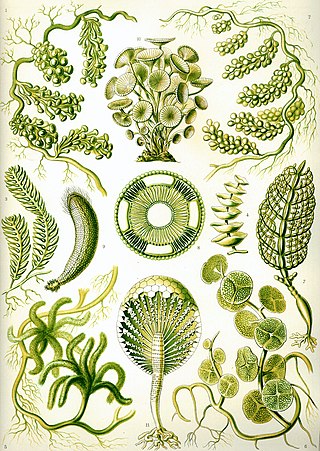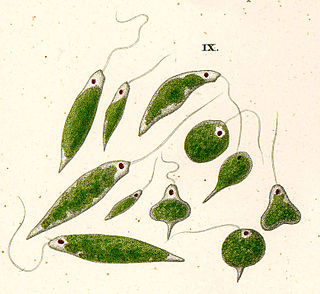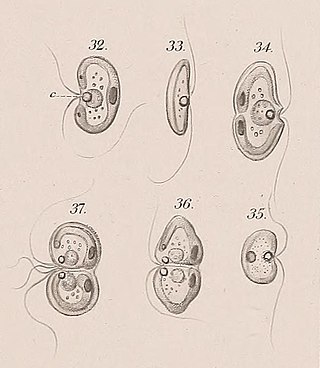Related Research Articles

Algae are any of a large and diverse group of photosynthetic, eukaryotic organisms. The name is an informal term for a polyphyletic grouping that includes species from multiple distinct clades. Included organisms range from unicellular microalgae, such as Chlorella, Prototheca and the diatoms, to multicellular forms, such as the giant kelp, a large brown alga which may grow up to 50 metres (160 ft) in length. Most are aquatic and lack many of the distinct cell and tissue types, such as stomata, xylem and phloem that are found in land plants. The largest and most complex marine algae are called seaweeds. In contrast, the most complex freshwater forms are the Charophyta, a division of green algae which includes, for example, Spirogyra and stoneworts. Algae that are carried by water are plankton, specifically phytoplankton.

Chlorophyta is a division of green algae informally called chlorophytes.

Phycology is the scientific study of algae. Also known as algology, phycology is a branch of life science.

Euglena is a genus of single cell flagellate eukaryotes. It is the best known and most widely studied member of the class Euglenoidea, a diverse group containing some 54 genera and at least 200 species. Species of Euglena are found in fresh water and salt water. They are often abundant in quiet inland waters where they may bloom in numbers sufficient to color the surface of ponds and ditches green (E. viridis) or red (E. sanguinea).

A plastid is a membrane-bound organelle found in the cells of plants, algae, and some other eukaryotic organisms. Plastids are considered to be intracellular endosymbiotic cyanobacteria.

Chlamydomonas is a genus of green algae consisting of about 150 species of unicellular flagellates, found in stagnant water and on damp soil, in freshwater, seawater, and even in snow as "snow algae". Chlamydomonas is used as a model organism for molecular biology, especially studies of flagellar motility and chloroplast dynamics, biogenesis, and genetics. One of the many striking features of Chlamydomonas is that it contains ion channels (channelrhodopsins) that are directly activated by light. Some regulatory systems of Chlamydomonas are more complex than their homologs in Gymnosperms, with evolutionarily related regulatory proteins being larger and containing additional domains.

The silicoflagellates are a small group of unicellular photosynthetic protists, or algae, belonging to the supergroup of eukaryotes known as Stramenopiles. They behave as plankton and are present in oceanic waters. They are well-known from harmful algal blooms that cause high mortality of fish. Additionally, they compose a rich fossil record represented by their silica skeletons.

The green algae are a group of chlorophyll-containing autotrophic eukaryotes consisting of the phylum Prasinodermophyta and its unnamed sister group that contains the Chlorophyta and Charophyta/Streptophyta. The land plants (Embryophytes) have emerged deep in the Charophyte alga as a sister of the Zygnematophyceae. Since the realization that the Embryophytes emerged within the green algae, some authors are starting to include them. The completed clade that includes both green algae and embryophytes is monophyletic and is referred to as the clade Viridiplantae and as the kingdom Plantae. The green algae include unicellular and colonial flagellates, most with two flagella per cell, as well as various colonial, coccoid (spherical), and filamentous forms, and macroscopic, multicellular seaweeds. There are about 22,000 species of green algae, many of which live most of their lives as single cells, while other species form coenobia (colonies), long filaments, or highly differentiated macroscopic seaweeds.

Euglenophyceae (ICBN) or Euglenea (ICZN) is a group of single-celled algae belonging to the phylum Euglenozoa. They have chloroplasts originated from an event of secondary endosymbiosis with a green alga. They are distinguished from other algae by the presence of paramylon as a storage product and three membranes surrounding each chloroplast.

The Archaeplastida are a major group of eukaryotes, comprising the photoautotrophic red algae (Rhodophyta), green algae, land plants, and the minor group glaucophytes. It also includes the non-photosynthetic lineage Rhodelphidia, a predatorial (eukaryotrophic) flagellate that is sister to the Rhodophyta, and probably the microscopic picozoans. The Archaeplastida have chloroplasts that are surrounded by two membranes, suggesting that they were acquired directly through a single endosymbiosis event by phagocytosis of a cyanobacterium. All other groups which have chloroplasts, besides the amoeboid genus Paulinella, have chloroplasts surrounded by three or four membranes, suggesting they were acquired secondarily from red or green algae. Unlike red and green algae, glaucophytes have never been involved in secondary endosymbiosis events.
The history of phycology is the history of the scientific study of algae. Human interest in plants as food goes back into the origins of the species, and knowledge of algae can be traced back more than two thousand years. However, only in the last three hundred years has that knowledge evolved into a rapidly developing science.

Chlorodendrales are an order of green, flagellated, thecate, unicellular eukaryotes, within the green algae class Chlorodendrophyceae. Prasinophyceae are defined by their cellular scales which are composed of carbohydrates, and Chlorodendrales are unique within this group due to these scales forming a fused thecal wall. Cells of Chlorodendrales are completely covered in scales, which fuse around the cell body producing the theca, but remain individually separated on the flagella, of which there are typically four per cell. Species within Chlorodendrales live in both marine and fresh water habitats, occupying both benthic and planktonic food webs. Additionally, they are photoautotrophs, meaning they produce their own food through the conversion of sunlight into chemical energy.

Nephroselmis is a genus of green algae. It has been placed in the family Nephroselmidaceae, although a 2009 study suggests that it should be separated into its own class, Nephroselmidophyceae. One species can be an endosymbiont of Hatena arenicola.
The Mesostigmatophyceae are a class of basal green algae found in freshwater. In a narrow circumscription, the class contains a single genus, Mesostigma. AlgaeBase then places the order within its circumscription of Charophyta. A clade containing Chlorokybus and Spirotaenia may either be added, or treated as a sister, with Chlorokybus placed in a separate class, Chlorokybophyceae. When broadly circumscribed, Mesostigmatophyceae may be placed as sister to all other green algae, or as sister to all Streptophyta.

Paulinella is a genus of at least eleven species including both freshwater and marine amoeboids. Like many members of euglyphids it is covered by rows of siliceous scales, and use filose pseudopods to crawl over the substrate of the benthic zone.
Mesostigma is a genus of unicellular biflagellate freshwater green algae, with a single species Mesostigma viride, covered by an outer layer of basket‐like scales instead of a cell wall. It is the only known genus in the class Mesostigmatophyceae.

Ochrophytes, also known as heterokontophytes or stramenochromes, are a group of algae. They are the photosynthetic stramenopiles, a group of eukaryotes, organisms with a cell nucleus, characterized by the presence of two unequal flagella, one of which has tripartite hairs called mastigonemes. In particular, they are characterized by photosynthetic organelles or plastids enclosed by four membranes, with membrane-bound compartments called thylakoids organized in piles of three, chlorophyll a and c as their photosynthetic pigments, and additional pigments such as β-carotene and xanthophylls. Ochrophytes are one of the most diverse lineages of eukaryotes, containing ecologically important algae such as brown algae and diatoms. They are classified either as phylum Ochrophyta or Heterokontophyta, or as subphylum Ochrophytina within phylum Gyrista. Their plastids are of red algal origin.

Guillardia is a genus of marine biflagellate cryptomonad algae with a plastid obtained through secondary endosymbiosis of a red alga.
Madura S. Balakrishnan (1917–1990) was born and raised in Madras, Madras Presidency, British India. He was a well-known botanist and he served various government positions and worked for some time at the University of Pune. He was the student of phycologist Professor M.O.P. Iyengar. The standard author abbreviation M.S.Balakr. is used to indicate this person as the author when citing a botanical name.

The rhizoplast is an organelle present in a variety of flagellates, including ochrophyte and chlorophyte algae and some fungi. This term is used for a variety of striated, fibrous root-like structures that attach to the basal bodies (kinetosome) of the flagella and end in some other organelle. In the strictest sense, the term refers specifically to a type of root that is composed of contractile microfibrils of centrin and connects directly to the surface of the cell nucleus.
References
- ↑ "Staff - Central Collection of Algal Cultures (CCAC)". www.uni-due.de. Retrieved 2024-10-06.
- 1 2 History of the European Phycological Congresses and the Foundation of FEPS. (PDF), Federation of European Phycological Societies, 2022
- ↑ "Home". Hellenic Phycological Society (HEL.P.S.). Retrieved 2024-10-06.
- ↑ "www.melkonian.uni-koeln.de". www.melkonian.uni-koeln.de. Retrieved 2024-10-06.
- ↑ "Algenion-biotec.de". Archived from the original on 2014-03-02. Retrieved 2014-03-31.
- ↑ "www.melkonian.uni-koeln.de". www.melkonian.uni-koeln.de. Retrieved 2024-10-06.
- ↑ Geimer, S., Melkonian, M. (2004): The ultrastructure of the Chlamydomonas reinhardtii basal apparatus: identification of an early marker of radial asymmetry inherent to the basal body. J. Cell Sci. 117, 2663-2674
- ↑ Salisbury, J.L., Baron, A., Surek, B., Melkonian, M. (1984): Striated flagellar roots: isolation and partial characterization of a calcium-modulated contractile organelle. J. Cell Biol. 99, 962-970
- ↑ Melkonian, M., Reize, I.B., Preisig, H.R. (1987): Maturation of a flagellum/basal body requires more than one cell cycle in algal flagellates: Studies on Nephroselmis olivacea (Prasinophyceae). In: Algal Development. Molecular and Cellular Aspects (Wiessner, W., Robinson, D.G., Starr, R.C., eds.), pp. 102-113. Berlin-Heidelberg: Springer-Verlag
- ↑ Becker, B., Bölinger, B., Melkonian, M. (1995): Anterograde transport of algal scales through the Golgi complex is not mediated by vesicles. Trends in Cell Biology 5 , 305-306
- ↑ Melkonian, M., Robenek, H. (1980): Eyespot membranes of Chlamydomonas reinhardii: a freeze-fracture study. J. Ultrastruct. Res. 72, 90-102
- ↑ Melkonian, M. (1982a): Structural and evolutionary aspects of the flagellar apparatus in green algae and land plants. Taxon 31, 255-265
- ↑ Marin, B., Palm, A., Klingberg, M., Melkonian, M. (2003): Phylogeny and taxonomic revision of plastid-containing Euglenophytes based on SSU rDNA sequence comparisons and synapomorphic signatures in the SSU rRNA secondary structure. Protist 154, 99-145
- ↑ Hess, S., Melkonian, M. (2013) The Mystery of Clade X: Orciraptor and Viridiraptor genera nova are highly specialised, algivorous amoeboflagellates (Glissomonadida, Cercozoa). Protist 164: 706-741
- ↑ Seenivasan, R., Sausen, N., Medlin, L.K., Melkonian, M. (2013) Picomonas judraskeda gen. et sp. nov.: The first identified member of the Picozoa phylum nov., a widespread group of picoeukaryotes, formerly known as ‘picobiliphytes.’ PLoS ONE 8(3): e59565
- ↑ Marin, B., Melkonian, M. (1999): Mesostigmatophyceae, a new class of streptophyte green algae revealed by SSU rRNA sequence comparisons. Protist 150, 399-417
- ↑ Wodniok, S., Brinkmann, H., Glöckner, G., Heidel, A.J., Philippe, H., Melkonian, M., Becker, B. (2011) Origin of land plants: Do conjugating green algae hold the key? BMC Evol. Biol. 11: 104
- ↑ Nowack, E.C.M., Melkonian, M., Glöckner, G. (2008): Chromatophore genome sequence of Paulinella sheds light on acquisition of photosynthesis by eukaryotes. Curr. Biol. 18, 410-418
- ↑ Naumann, T., Çebi, Z., Podola, B., Melkonian, M. (2013) Growing microalgae as aquaculture feeds on Twin-Layers, a novel solid state photobioreactor. J. Appl. Phycol. 25: 1413-1420
- ↑ International Plant Names Index. Melkonian.
- ↑ "Editorial board - Protist | ScienceDirect.com by Elsevier". www.sciencedirect.com. Retrieved 2024-10-06.
- ↑ "Botanical Society of America". Archived from the original on 2018-08-11. Retrieved 2014-04-14.
- ↑ Hellenic Phycological Society (HEL.P.S.)
- ↑ Biology Prize Archived 2014-11-07 at the Wayback Machine , Göttingen Academy of Sciences
- ↑ Fritz Schaudinn Award
- ↑ "Hans-Adolf von Stosch Medal". Archived from the original on 2014-11-06. Retrieved 2014-04-22.
- ↑ Algal Cell Motility. doi:10.1007/978-1-4615-9683-7.